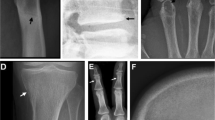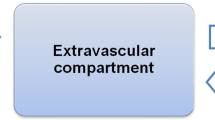Abstract
Objective
The study aims to assess regional and total bone metabolic activity in patients with chronic kidney disease using Na[18F]F PET and correlation between semi-quantitative indices and blood parameters.
Methods
Seventy-two subjects (mean age 61.8 ± 13.8 years) were included. Of these 24/72 patients had end-stage renal disease (ESRD) (GFR < 15 mL/min/1.73 m2), 38/72 had chronic kidney disease (CKD) (GFR between 60 and 15 mL/min/1.73 m2), and 10/72 were controls with normal renal function. All subjects underwent Na[18F]F PET-CT with a dose activity of 0.06 mCi/Kg. Regional and total skeletal metabolism were assessed with mean SUVs in a skeletal volume of interest (VOI), bone to soft tissue index (B/S), global SUV mean (GSUV mean) of the whole bone, and uptake in the femoral neck.
Results
Statistically significant differences were observed in a number of 18F-NaF metrics like femoral neck metabolism in CKD and ERSD groups in comparison to control in right (P = 0.003) and left femur (P = 0.006), bone to soft tissue index in the femur (P = 0.016) and GSUV5 (P = 0.006). There is also a significant difference in SUV mean in lumbar vertebrae (L1–L4) among CKD, ESRD, and controls. There was a moderate correlation between 18F-NaF PET scan uptake and blood parameters such as ALP and PTH. Na[18F]F uptake parameters were significantly different in low versus high bone turnover state.
Conclusions
The assessment of total skeleton and regional metabolism and bone turnover in CKD patients is feasible with Na[18F]F PET. Na[18F]F can help to detect early changes in bone metabolism and assess the progression of bone disease in this complex condition. Quantification with Na[18F]F PET might provide better assessment of the bone turnover. The difference in Na[18F]F uptake in CKD compared to controls is likely related to a change in bone turnover which, however, requires further validation.



Similar content being viewed by others
Data availability
The data of this study can be available on request from the corresponding author.
References
Jha V, Gaecia-Garcia G, Iseki K, et al. Chronic kidney disease: global dimension and perspectives. Lancet. 2013;382:260–72.
National Institutes of Health. 2016 USRDS Annual Data Report: Epidemiology of Kidney Disease in the United States. Bethesda, MD: National Institutes of Health, National Institute of Diabetes and Digestive and Kidney Diseases; 2016.
Ketteler M, Block GA, Evenepoel P, et al. KDIGO 2017 clinical practice guideline update for the diagnosis, evaluation, prevention, and treatment of CKD-MBD. Kidney Int Suppl. 2017;7(Suppl 1):1–59.
Coen G, Ballanti P, Bonucci E, et al. Renal osteodystrophy in predialysis and hemodialysis patients: comparison of histologic patterns and diagnostic predictivity of intact PTH. Nephron. 2002;91:103–11.
Fukagawa M, Hamada Y, Nakanishi S, et al. The kidney and bone metabolism: a nephrologist’s view. J Bone Miner Metab. 2006;24:434–8.
National Kidney Foundation. K/DOQI clinical practice guidelines for bone metabolism and disease in chronic kidney disease. Am J Kidney Dis. 2003;42(suppl 3):S1-201.
Green AD, Colon-Emeric CS, Bastian L, et al. Does this woman have osteoporosis? JAMA. 2004;292:2890–900.
Hygum K, Starup-Linde J, Harsløf T, et al. The diurnal variation of bone formation is attenuated in adult patients with type 2 diabetes. Eur J Endocrinol. 2019;181:221–31.
Lehmann G, Stein G, Hüller M, et al. Specific measurement of PTH (1–84) in various forms of renal osteodystrophy (ROD) as assessed by bone histomorphometry. Kidney Int. 2005;68:1206–14.
Sprague SM, Bellorin-Font E, Jorgetti V, et al. Diagnostic accuracy of bone turnover markers and bone histology in patients with CKD treated by dialysis. Am J Kidney Dis. 2016;67:559–66.
Salam S, Gallagher O, Gossiel F, Paggiosi M, Khwaja A, Eastell R. Diagnostic accuracy of biomarkers and imaging for bone turnover in renal osteodystrophy. J Am Soc Nephrol. 2018;29:1557–65.
Evenepoel P, Behets GJS, Laurent MR, D’Haese PC. Update on the role of bone biopsy in the management of patients with CKD-MBD. J Nephrol. 2017;30:645–52.
Czernin J, Satyamurthy N, Schiepers C. Molecular mechanisms of bone 18F-NaF deposition. J Nucl Med. 2010;51:1826–9.
Grant FD, Fahey FH, Packard AB, et al. Skeletal PET with 18F-fluoride: applying new technology to an old tracer. J Nucl Med. 2008;49:68–78.
Raynor W, Houshmand S, Gholami S, et al. Evolving role of molecular imaging with (18)F-sodium fluoride PET as a biomarker for calcium metabolism. Curr Osteoporos Rep. 2016;14:115–25.
Kidney Disease: Improving Global Outcomes (KDIGO) CKDMBD Working Group. KDIGO clinical practice guideline for the diagnosis, evaluation, prevention, and treatment of chronic kidney disease–mineral and bone disorder (CKD–MBD). Kidney Int. 2009;76(Suppl 113):S1–130.
Lasnon C, Salomon T, Desmonts C, Dô P, Oulkhouir Y, Madelaine J, et al. Generating harmonized SUV within the EANM EARL accreditation program: software approach versus EARL-compliant reconstruction. Ann Nucl Med. 2017;31:125–34.
Raynor W, Ayubcha C, Shamchi SP, Zadeh MZ, Emamzadehfard S, Werner T, et al. Assessing global uptake of 18F-sod fluoride in the femoral neck: a novel quantitative technique to evaluate changes in bone turnover with age. J Nucl Med. 2017;58:1223.
Raynor W, Houshmand S, Gholami S, Werner T, Alavi A. Assessment of bone turnover by measuring global uptake of 18F- sodium fluoride in the femoral neck, a novel method for early detection of osteoporosis. J Nucl Med. 2016;57:1769.
Zirakchian Zadeh M, Østergaard B, Raynor WY, et al. Comparison of 18F-sodium fluoride uptake in the whole bone, pelvis, and femoral neck of multiple myeloma patients before and after high-dose therapy and conventional-dose chemotherapy. Eur J Nucl Med Mol Imaging. 2020;47:2846–55.
Evans JD. Straightforward statistics for the behavioral sciences. Thomson Brooks/Cole Publishing Co; 1996.
Hosmer DW, Lemeshow S. Applied logistic regression. 2nd ed. New York, NY: Wiley; 2000. p. 160–4.
Kurata S, Ishibashi M, Nishida H, Hiromatsu Y, Hayabuchi N. A clinical assessment of the relationship between bone scintigraphy and serum biochemical markers in hemodialysis patients. Ann Nucl Med. 2004;18:513–8.
Nishida H, Kaida H, Ishibashi M, et al. Usefulness of bone uptake ratio of bone scintigraphy in hemodialysis patients. Ann Nucl Med. 2005;19:91–4.
Frost ML, Blake GM, Park-Holohan SJ, et al. Long-term precision of 18F-fluoride PET skeletal kinetic studies in the assessment of bone metabolism. J Nucl Med. 2008;49:700–7.
Jadvar H, Desai B, Conti PS. Sodium 18F-fluoride PET/CT of bone, joint, and other disorders. Semin Nucl Med. 2015;45:58–65.
Hawkins RA, Choi Y, Huang SC, et al. Evaluation of the skeletal kinetics of fluorine-18-fluoride ion with PET. J NuclMed. 1992;33:633–42.
Frost ML, Cook GJR, Blake GM, et al. A prospective study of risedronate on regional bone metabolism and blood flow at the lumbar spine measured by 18F fluoride positron emission tomography. J Bone Miner Res. 2003;18:2215–22.
Aaltonen L, Koivuviita N, Seppänen M, et al. Bone histomorphometry and 18F-sodium fluoride positron emission tomography imaging: comparison between only bone turnover-based and unified TMV-based classification of renal osteodystrophy. Calcif Tissue Int. 2021;109:605–14.
Puri T, Frost ML, Moore AEB, et al. Utility of a simplified [18F] sodium fluoride PET imaging method to quantify bone metabolic flux for a wide range of clinical applications. Front Endocrinol (Lausanne). 2023;14:1236881.
Uchida K, Nakajima H, Miyazaki T, et al. Effects of alendronate on bone metabolism in glucocorticoid-induced osteoporosis measured by 18F-fluoride PET: a prospective study. J Nucl Med. 2009;50:1808–14.
Siddique M, Frost ML, Blake GM, et al. The precision and sensitivity of (18)F-fluoride PET for measuring regional bone metabolism: a comparison of quantification methods. J Nucl Med. 2011;52:1748–55.
Usmani S, Marafi F, Esmail A, et al. A proof of concept study analyzing the clinical utility of 18F-sodium fluoride (NaF) PET-CT in skeletal staging of oncology patients with end-stage renal disease on dialysis. Nucl Med Commun. 2017;38:1067–75.
Assiri R, Knapp K, Fulford J, Chen J. Correlation of the quantitative methods for the measurement of bone uptake and plasma clearance of 18F-NaF using positron emission tomography: systematic review and meta-analysis. Eur J Radiol. 2022;146: 110081.
Rhodes S, Batzdorf A, Sorci O, et al. Assessment of femoral neck bone metabolism using 18F-sodium fluoride PET/CT imaging. Bone. 2020;136: 115351.
Zadeh MZ, Raynor WY, Seraj SM, et al. Evolving roles of fluorodeoxyglucose and sodium fluoride in assessment of multiple myeloma patients: introducing a novel method of PET quantification to overcome shortcomings of the existing approaches. PET Clin. 2019;14:341–52.
Messa C, Goodman WG, Hoh CK, et al. Bone metabolic activity measured with positron emission tomography and [18F]fluoride ion in renal osteodystrophy: correlation with bone histomorphometry. J Clin Endocrinol Metab. 1993;77:949–55.
Aaltonen L, Koivuviita N, Seppänen M, et al. Correlation between 18F-sodium fluoride positron emission tomography and bone histomorphometry in dialysis patients. Bone. 2020;134: 115267.
Usmani S, Ahmed N, Gnanasegaran G, Marafi F, van den Wyngaert T. Update on imaging in chronic kidney disease-mineral and bone disorder: promising role of functional imaging. Skelet Radiol. 2022;51:905–22.
Deng Y, Shen X, Lei L, Zhang W. Osteitis fibrosa cystica caused by hyperparathyroidism shown on 18F-NaF PET/CT. Clin Nucl Med. 2020;45:577–9.
Graf C, Huellner M, Tschopp O, Bode-Lesniewska B, Schmid C. (18)F-NaF-PET/CT in patients with primary hyperparathyroidism and brown tumors. J Bone Miner Metab. 2020;38:299–309.
Pontoriero G, Cozzolino M, Locatelli F, Brancaccio D. CKD patients: the dilemma of serum PTH levels. Nephron Clin Pract. 2010;116:c263–8.
Author information
Authors and Affiliations
Corresponding author
Ethics declarations
Conflict of interest
The authors declare that they have no conflict of interest. No financial help or grant is taken by any governmental and non-governmental organization.
Ethical approval
All procedure performed in studies involving human participants were in accordance with the ethical standard of the institutional and/or national research committee and with the 1964 Helsinki Declaration and its later amendments or comparable ethical standards.
Informed consent
The institutional review board of our institute approved this study and all subjects provided informed consent for study participation.
Additional information
Publisher's Note
Springer Nature remains neutral with regard to jurisdictional claims in published maps and institutional affiliations.
Supplementary Information
Below is the link to the electronic supplementary material.
Rights and permissions
Springer Nature or its licensor (e.g. a society or other partner) holds exclusive rights to this article under a publishing agreement with the author(s) or other rightsholder(s); author self-archiving of the accepted manuscript version of this article is solely governed by the terms of such publishing agreement and applicable law.
About this article
Cite this article
Usmani, S., Ahmed, N., Gnanasegaran, G. et al. Assessment of regional and total skeletal metabolism using 18F-NaF PET/CT in patients with chronic kidney disease. Ann Nucl Med (2024). https://doi.org/10.1007/s12149-024-01929-1
Received:
Accepted:
Published:
DOI: https://doi.org/10.1007/s12149-024-01929-1




